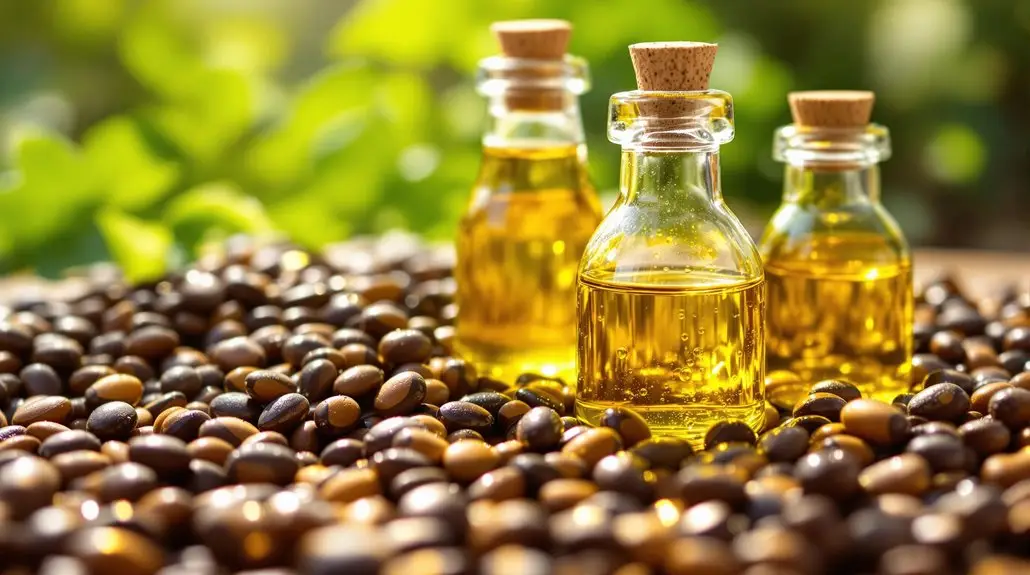Castor oil, mainly made up of ricinoleic acid, shows promising pesticidal activity against various pests. With a composition that includes other fatty acids, it serves as an effective natural alternative to synthetic pesticides. You’ll find it works well against pests like *Ae. aegypti* and *Leucinodes orbonalis*, offering a broad-spectrum approach to pest control. Its biodegradable nature and low toxicity make it a secure choice in gardening. When combined with other natural ingredients, it can greatly enhance its pest-repelling effects. Keep exploring, and you’ll discover even more innovative uses and formulations for this versatile oil.
Key Insights
- Castor oil primarily contains ricinoleic acid, accounting for 75-90% of its composition, contributing to its pesticidal properties.
- Effective against various pests, including *Ae. aegypti* and *Leucinodes orbonalis*, demonstrating broad-spectrum pest control capabilities.
- Formulations range from 40% to 90% castor oil concentration, with specific mixes enhancing efficacy against target pests.
- Biodegradable and low in toxicity, castor oil is suitable for environmentally friendly pest management practices.
- Future research aims to optimize formulations and investigate castor oil’s role as a carrier for other bioactive substances in pest control.
Composition of Castor Oil
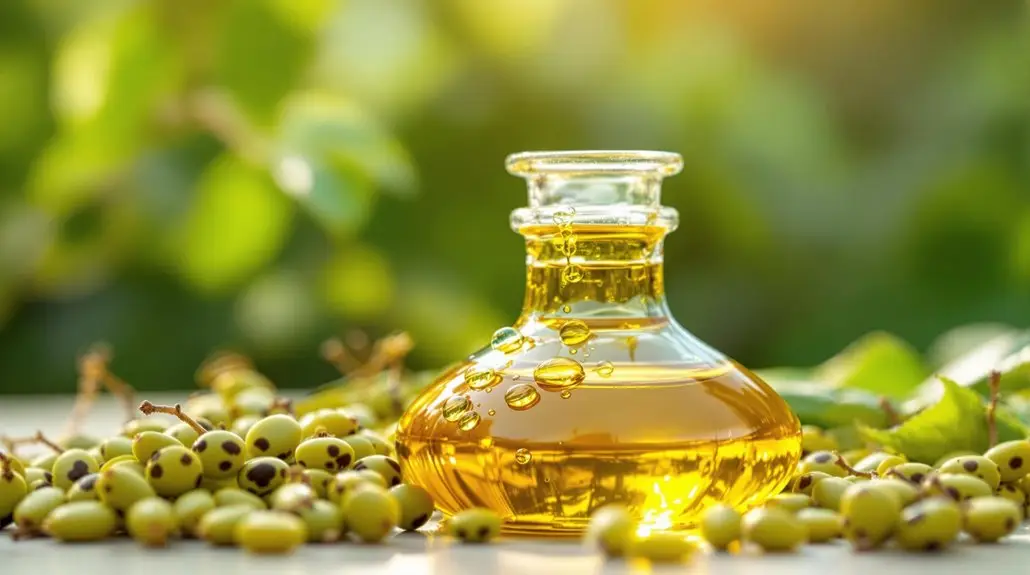
When you look at the composition of castor oil, you’ll find that ricinoleic acid is its star player, making up about 75-90% of the oil. This unique fatty acid isn’t just a number; it’s what gives castor oil its distinctive properties and potential benefits.
Alongside ricinoleic acid, you’ll discover other fatty acids like oleic, stearic, palmitic, linoleic, and linolenic acids, each contributing to the oil’s diverse functionality.
The oil mainly consists of triglycerides, with triricinolein being the most abundant. This composition adds to the oil’s richness and effectiveness.
You’ll also notice the presence of neutral lipids and various minor biological active compounds that enhance its benefits. For instance, the unsaponifiable fractions include carotenoids, phenolics, and phytosterols, all working together to boost oxidation stability and provide antioxidant properties. Additionally, castor oil is known for its therapeutic compounds that contribute to its healing and moisturizing effects.
With a melting point of -10 °C and a boiling point of 313 °C, castor oil shows impressive physical characteristics. It’s worth noting that it’s insoluble in water, which makes it quite versatile for various applications. Additionally, castor oil is known for its reactivity with acids and alcohols, generating heat during these interactions.
The density and viscosity further define its usability in different formulations.
As you explore deeper into castor oil’s composition, you’ll appreciate how each element plays a part in its overall efficacy.
Embracing castor oil means connecting with a rich history of natural remedies, where every drop carries the essence of nature’s best-kept secrets.
Active Ingredients in Pesticides
When exploring active ingredients in pesticides, you’ll find that many natural insecticidal components play a vital role in their effectiveness. Emulsifiers and solvents are also key, helping to enhance the delivery and stability of these active ingredients. Additionally, other bioactive ingredients can further improve pest control while minimizing environmental impact. Understanding the role of active ingredients is crucial for assessing the overall effectiveness of any pesticide formulation. Recent reviews conducted by the MDA on new pesticide active ingredients highlight the importance of analyzing risk assessments to ensure human health and ecological safety. The growing trend towards natural and organic solutions reflects a shift in consumer preferences towards safer pest management options.
Natural Insecticidal Components
Natural insecticidal components play an essential role in pest management by providing effective alternatives to synthetic pesticides. You’ll find that these natural solutions not only protect your plants but also support a sustainable approach to gardening. Here are four key components to weigh:
- Ricinoleic Acid: Found in castor oil, it exhibits larvicidal and adulticidal activities, especially against mosquitoes. Research has shown that castor oil’s effectiveness includes larvicidal activity with an LC50 of 51.38 ppm against Aedes aegypti.
- Neem Oil: This powerhouse disrupts pest life cycles, targeting aphids, mealybugs, and whiteflies effectively.
- Diatomaceous Earth: A natural abrasive, it dehydrates insects, proving effective against snails and slugs.
- Essential Oils: Oils from cinnamon, rosemary, and peppermint are increasingly used in commercial formulations, offering a pleasant scent while repelling pests. In fact, some essential oils have shown 50-100% effectiveness against invasive pests like SWD.
These components not only help you manage pests but also align with a growing desire for eco-friendly practices. By choosing natural insecticides, you’re contributing to a healthier ecosystem while ensuring your garden thrives. Embracing these options fosters a sense of belonging within a community that values both sustainability and effective pest control.
Emulsifiers and Solvents Usage
Emulsifiers and solvents are essential components in the formulation of pesticides, ensuring effective delivery and stability of active ingredients.
You’ll find that emulsifiers like dibenzyl biphenyl-based polyoxyethylene ether and alkyl phenol formaldehyde resin polyoxyethylene are vital for mixing and wetting in various pesticide formulations. These non-ionic and anionic surfactants help enhance the emulsification process, allowing for better application. Additionally, the use of pesticide emulsifiers is crucial for enhancing the stability and efficacy of pesticide applications.
When it comes to solvents, petroleum-based options are commonly used in Emulsifiable Concentrate (EC) herbicides. They dissolve active ingredients and enable a stable emulsion when mixed with water. This is particularly important as EC herbicides contain a significant percentage of active ingredient, ensuring effective weed control.
Solvents like acetone and etoxazole are selected based on their solubility properties, ensuring compatibility with both the active ingredient and emulsifier.
Additional Bioactive Ingredients
The effectiveness of pesticide formulations heavily relies on the active ingredients they contain. Understanding these components helps you make informed choices for pest control while considering security and efficacy.
Here’s a quick overview of some key categories of active ingredients you might encounter:
- Conventional: These are all the ingredients aside from biological and antimicrobial pesticides, focusing on broad-spectrum control.
- Antimicrobial: These substances target harmful microorganisms, effectively suppressing their growth.
- Biopesticides: Derived from natural materials, they offer an eco-friendly option for pest management.
- Plant-derived Compounds: Ingredients like matrine, nimbin, and rotenone are used for their insecticidal properties.
When selecting active ingredients, think about the type of pest you’re dealing with and the impact on the environment. Additionally, assessing conducive conditions can help in formulating effective control strategies.
You’ll want something effective yet secure for both humans and wildlife. As you navigate the world of pesticides, remember that the right active ingredients can make all the difference in achieving successful pest control while fostering a healthier ecosystem.
Insecticidal Effects of Castor Oil
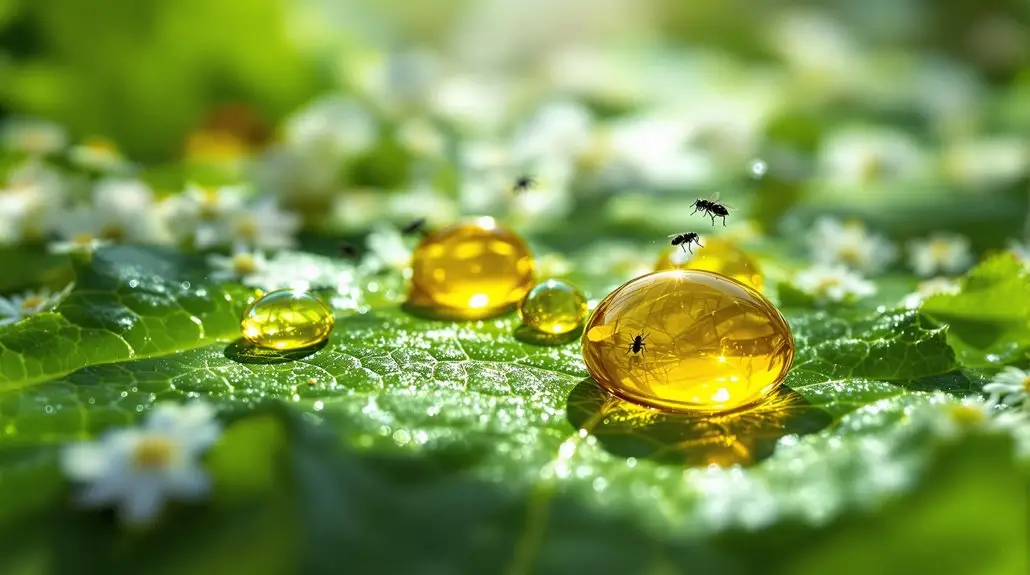
When you explore the insecticidal effects of castor oil, you’ll find it has strong larvicidal efficacy against various pests, particularly the dengue vector, Ae. aegypti. Its adulticidal activity further enhances its effectiveness, making it a versatile tool for pest management. Plus, castor oil’s broad spectrum effectiveness allows it to tackle multiple pests, leading to improved productivity in crops. Additionally, castor oil is commonly included in natural commercial pesticides, which underscores its value in sustainable gardening practices. Notably, castor oil has shown significant efficacy against Leucinodes orbonalis, a major pest of aubergine crops, demonstrating its potential in agricultural pest management.
Larvicidal Efficacy Overview
Castor oil demonstrates notable larvicidal efficacy against various mosquito species, making it a compelling option for pest control. Its unique properties and active components offer a natural alternative to synthetic pesticides. Here’s what you should know:
- Effective Concentrations: The LC50 for castor oil against *Ae. aegypti* is 51.38 ppm, while its nanoemulsion variant boasts an impressive LC50 of just 3.4 ppm against *An. culicifacies*.
- Active Ingredients: Ricinoleic acid and ricinine are key components that disrupt cell membranes or suffocate larvae, enhancing castor oil’s effectiveness. Pesticides remain a primary strategy for pest control in agriculture, highlighting the importance of exploring alternatives like castor oil.
- Comparative Advantage: Studies reveal that the nanoemulsion formulation outperforms bulk emulsions, increasing larval mortality rates notably.
- Environmental Security: Castor oil nanoemulsion is biodegradable, non-toxic, and reliable for many plant species, making it an eco-friendly pest control option.
Adulticidal Activity Findings
Adulticidal activity findings reveal that castor oil serves as a potent insecticide against various adult pests, particularly mosquitoes. Research shows that at concentrations of 6.03 µg/mg, castor oil achieves a significant adulticidal effect after just 24 hours. You’ll notice the effectiveness increases with higher concentrations, reaching a notable 25.07 µg/mg LD90. Studies indicate that castor oil effectively targets the dengue vector, *Ae. aegypti*, and extends its efficacy to other adult pests like ticks, termites, and cockroaches. When you apply it topically, especially on adult mosquitoes, you’ll see marked mortality rates. Its potential isn’t limited to just mosquitoes; castor oil can also control pests in your garden, such as *Leucinodes orbonalis*, making it a versatile choice. As a non-toxic and biodegradable option, it aligns perfectly with eco-friendly practices. Additionally, its role as a key ingredient in natural insecticide formulations emphasizes the importance of combining it with other essential oils for enhanced efficacy. Castor oil’s anti-inflammatory properties may also help soothe skin irritations caused by insect bites. For sustained pest control, consider weekly applications.
Broad Spectrum Effectiveness
You might be surprised to learn that castor oil offers broad-spectrum effectiveness as an insecticide, targeting a wide range of pests beyond just mosquitoes. Its versatility makes it a fantastic option for those who want to embrace sustainable pest management.
Here are some key points about its insecticidal effects:
- Diverse Targets: Castor oil effectively combats pests like aphids, spider mites, and even soil pests such as moles and voles.
- Synergistic Power: When combined with other insecticides, castor oil enhances their effectiveness, broadening the scope of pest control.
- Low Toxicity: It’s secure for humans, pets, and wildlife, allowing you to manage pests without worrying about harmful residues.
- Environmental Benefits: Being biodegradable, castor oil minimizes pollution while providing a natural deterrent against various harmful insects. Additionally, its anti-bacterial properties help in reducing the risk of pest-borne diseases.
Practical Applications in Gardening
Gardening enthusiasts often seek natural solutions to pest problems, and castor oil offers an effective option. By mixing three tablespoons of castor oil and one tablespoon of dish soap with a gallon of water, you create a powerful solution to repel pests.
Apply this mixture directly onto the soil, plants, and any tunnels or entry points created by troublesome critters. For larger areas, a hose-end sprayer works wonders, ensuring that only castor oil and soap are used. You’ll want to repeat this treatment every few weeks or after heavy rainfall, specifically targeting areas that show signs of damage. Castor oil is a natural and non-toxic solution that can help maintain the health of your garden without harming the environment. Additionally, it is important to note that eco-friendly pest control methods can greatly enhance your gardening efforts.
Castor oil shines in its effectiveness against a variety of pests. It can help deter moles, voles, gophers, raccoons, skunks, and even armadillos.
You’ll find that it disrupts their feeding and nesting behaviors with its distinct scent and taste. It’s also useful against the dengue vector, Ae. aegypti, and can control pests like Leucinodes orbonalis in aubergines, leading to higher productivity in your garden.
However, remember to wear gloves and protective clothing when applying it, as it can irritate your skin. Be cautious around pets, too, since ingestion can lead to gastrointestinal discomfort.
Formulation Examples
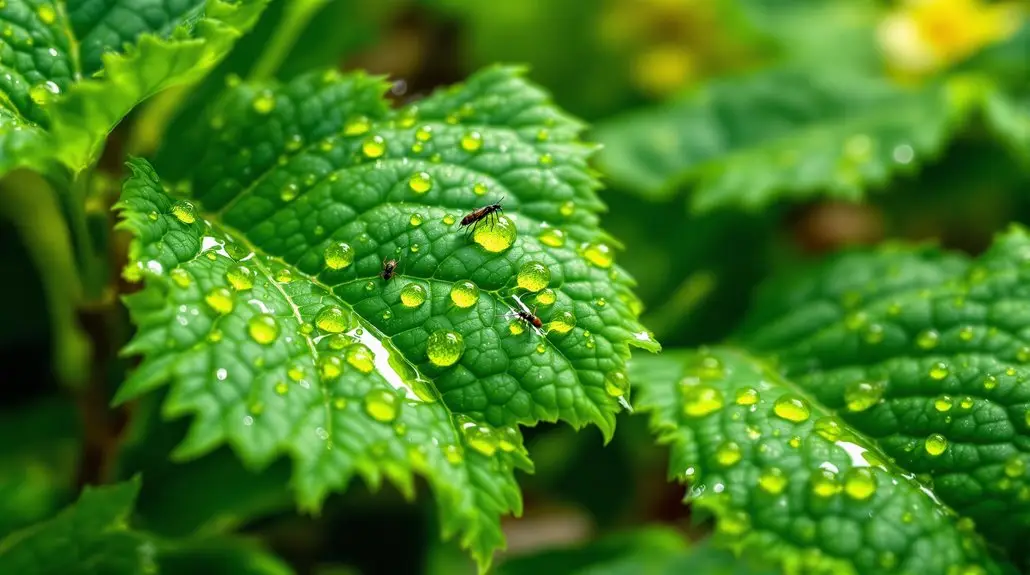
Now that you understand the practical applications of castor oil in gardening, let’s explore some formulation examples.
You’ll see how key ingredients, application techniques, and performance comparisons play a vital role in creating effective pesticidal compositions.
Key Ingredients Overview
Often, formulations utilizing castor oil incorporate a blend of various active ingredients to enhance their pesticidal effectiveness.
Here’s a quick overview of key components you might encounter:
- Castor Oil: Acts as the primary carrier, providing inherent pesticidal properties thanks to ricinoleic acid.
- Plant-Based Pesticides: Ingredients like matrine and rotenone offer broad-spectrum insecticidal action, appealing to those who prefer natural solutions.
- Synthetic Pesticides: Compounds such as Biphenthrin and cyhalothrin target specific pests, ensuring effective control for your gardens.
- Additives: Emulsifiers and auxiliary agents stabilize formulations, enhancing performance and ease of application.
Each formulation balances these components differently.
For instance, one might include 50% castor oil with 2% rotenone, while another could have 66.8% castor oil with various additives.
Knowing these combinations can help you choose the right product for your needs.
With castor oil-based formulations, you join a movement towards more secure, environmentally friendly pest control, ensuring a healthier space for everyone in your community.
Application Techniques
Understanding how to effectively apply castor oil-based formulations can greatly enhance your pest control efforts. You can create various formulations by adjusting the percentage of castor oil, typically ranging from 40.0% to 90.0%. For instance, a formulation with 50.0% castor oil can be effective against specific pests, while a 66.8% concentration might provide broader relief.
Here’s a simple breakdown of some formulation examples:
| Castor Oil Percentage | Active Ingredient | Purpose |
|---|---|---|
| 50.0% | Dish Soap | Soil application for voles |
| 66.8% | Cartap Hydrochloride | Antibacterial activity |
| 40.0% | Emulsifier | Enhance pesticide efficacy |
| 90.0% | None | Strong repellent for animals |
When applying castor oil in your garden, mix it with dish soap and water. Use a hose-end attachment for even distribution and apply weekly, even during rainy seasons, to maintain effectiveness. This not only helps repel pests but also contributes to a healthier garden environment you can be proud of.
Performance Comparisons
Performance comparisons of castor oil-based formulations reveal considerable differences in efficacy based on the concentration of castor oil and the choice of active ingredients. Understanding these variations can help you choose the right formulation for your needs.
Here are some remarkable examples:
- Castor Oil and Rotenone: This mix contains 50.0% castor oil and targets aphids and insects on green vegetables and tea leaves.
- Castor Oil and First Dimension Salt: With 66.8% castor oil, this formulation is effective against pests affecting green vegetables and tea leaves.
- Cartap Hydrochloride Formulation: This castor oil-based option shows high effectiveness against Xanthomonas oryzae.
- Agrimycin Formulation: By combining castor oil with agrimycin, you get a 44% higher zone of inhibition against Xanthomonas oryzae compared to just using aqueous agrimycin.
These performance comparisons emphasize how ingredient combinations and concentrations greatly influence the effectiveness of castor oil-based pesticides. Notably, studies indicate that the use of castor oil can significantly reduce pesticide residues, leading to enhanced fruit quality and safety.
You’ll find that selecting the right formulation not only enhances efficacy but also aligns with your commitment to sustainable practices.
Properties of Castor Oil
What makes castor oil stand out among other oils? Its unique properties set it apart, making it a versatile and valuable resource.
For starters, castor oil is a colorless or pale yellow liquid, often recognized by its distinct taste and odor. With a boiling point of 313 °C (595 °F) and a density of around 0.961 g/cm³, it’s particularly different from many other oils you might encounter. Its viscosity ranges from 1.6 to 2.8 Poise at 25°C, which means it flows differently, giving it exceptional low-temperature performance. Furthermore, the cultivation of castor has raised health and safety concerns due to the presence of ricin, a potent toxin found in its seeds.
The chemical composition adds to its uniqueness, primarily composed of ricinoleic acid, which accounts for 75 to 90% of the oil. This monounsaturated fatty acid is accompanied by oleic and linoleic acids, forming a complex mixture of triglycerides. The presence of a hydroxyl group on ricinoleic acid’s 12th carbon makes castor oil more polar, allowing for chemical reactions not possible with other seed oils. Additionally, the oil’s potential in developing sustainable materials has garnered attention for its role in advancing eco-friendly practices.
In industrial settings, castor oil shines as a lubricant for jet and racing cars, thanks to its superb low- and high-temperature properties. It’s also a key ingredient in manufacturing soaps, paints, and biodiesel.
With an annual production of 270,000–360,000 tonnes, castor oil commands a higher price than many other seed oils, reflecting its demand and diverse applications. All these factors make castor oil a remarkable oil that belongs in your toolkit, whether for everyday use or industrial applications.
Safety and Toxicity Overview
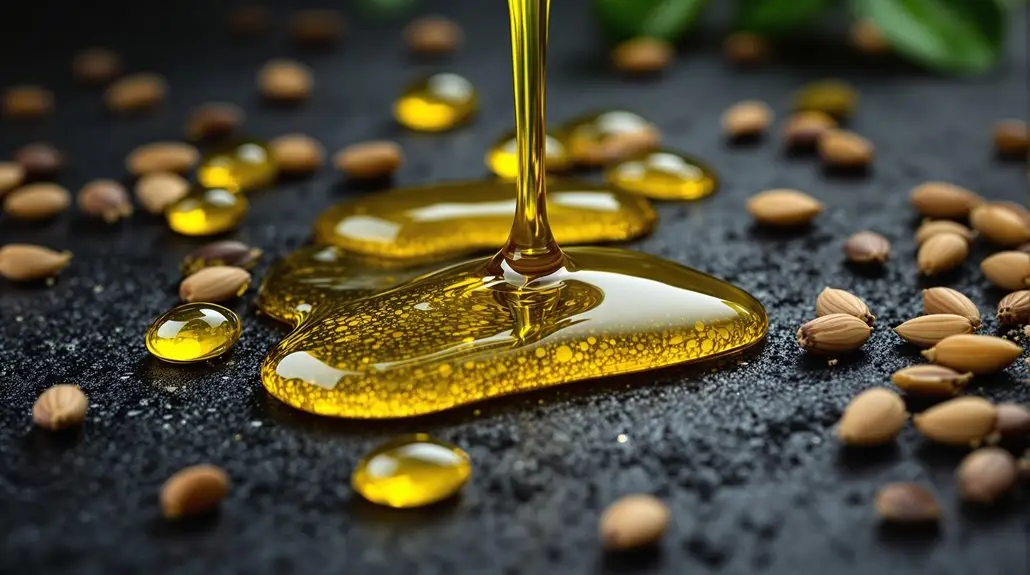
Castor oil’s protection and low toxicity profile make it an appealing choice for use as a pesticide. When you’re considering options for pest control, knowing that castor oil poses minimal risk to humans and livestock is reassuring.
Here are some key points that highlight its security:
- Low Mammalian Toxicity: Castor oil exhibits low toxicity levels, making it secure for both humans and animals.
- No Reproductive Toxicity: Studies confirm no reproductive toxicity even at higher concentrations, ensuring it won’t affect future generations.
- Minimal Risk Active Ingredient: The EPA classifies castor oil as a minimal risk active ingredient, which means it’s secure for use in various settings.
- Lack of Allergic Reactions: Hydrogenated castor oil, often used in pharmaceuticals, has shown no significant allergic reactions, enhancing its security profile.
With castor oil, you can feel confident knowing you’re choosing a pesticide that doesn’t compromise security. Its non-polluting nature and low residues make it suitable for organic farming, which is important for those who value sustainable practices. Additionally, castor oil is recognized as a viable option for sustainable bioenergy production, which aligns with the growing demand for eco-friendly agricultural practices.
Plus, since it’s biodegradable, you’re contributing to a healthier environment.
Environmental Impact
The environmental impact of castor oil is particularly positive, reflecting its role as a sustainable resource. By choosing castor oil, you’re supporting a process that boasts a low environmental impact, with only 9.74% harm for biofuel purposes. Additionally, castor oil is considered environmentally friendly biomass, which aligns with efforts to reduce the overall ecological footprint.
It’s not just about numbers; using castor oil can help regenerate soils in semi-arid regions, enhancing the health of our planet. When you engage with castor oil production, you’re also contributing to increased biodiversity. This means a richer ecosystem, which is something we all value.
The production process itself reduces emissions of harmful gases, aligning with our shared goal of fighting climate change. Plus, it promotes forest conservation, helping to halt deforestation and protect our green spaces. Using castor oil-based pesticides offers even more benefits. They’re considered non-polluting and have low mammalian toxicity, making them more secure for both you and the environment.
You’ll find that these pesticides leave minimal residues while effectively managing a wide range of pests.
Comparison With Synthetic Pesticides
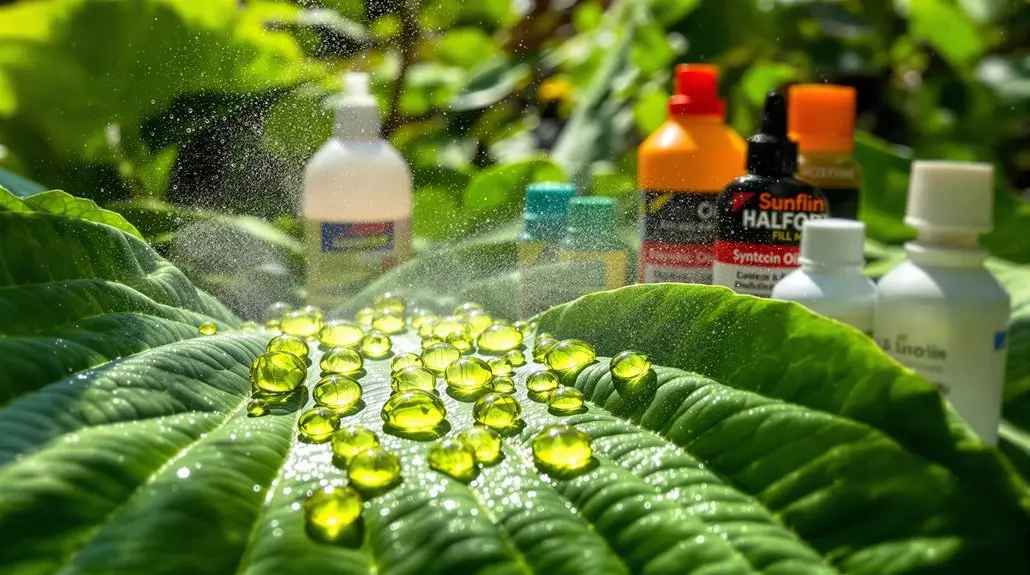
While the environmental benefits of castor oil are clear, its effectiveness as a pesticide invites comparison with synthetic alternatives. When you look closely, you’ll find that castor oil holds its own against traditional synthetic pesticides in several key areas:
- Efficacy: Castor oil shows comparable effectiveness to synthetic pesticides, especially at a 7.5 l/ha dose for controlling pests like Leucinodes orbonalis.
- Security: With low mammalian toxicity, castor oil provides a more secure option, eliminating the systemic toxicities often associated with synthetic options.
- Broad spectrum: It’s effective against a wide range of pests, including troublesome mosquitoes like Ae. aegypti, making it versatile for various agricultural needs.
- Sustainability: Using castor oil supports environmentally friendly farming practices, allowing you to contribute positively to the ecosystem. Additionally, castor oil is produced without synthetic pesticides and harmful chemicals, enhancing its appeal as an eco-conscious choice.
As you consider these factors, it’s clear that castor oil not only rivals synthetic pesticides in effectiveness but also excels in security and sustainability.
Choosing castor oil means you’re opting for a pesticide that aligns with a healthier planet, while still maintaining effective pest control in your garden or farm.
Embracing this natural solution can foster a sense of community among those seeking more secure, sustainable agricultural practices.
Future Research Directions
Exploring the future research directions for the pesticidal composition of castor oil reveals exciting opportunities to enhance its effectiveness and sustainability. You’ll want to engage in the exploration of bioactive compounds within castor oil. Research can focus on isolating these compounds to identify which ones contribute most to its pesticidal properties. Also, consider investigating how castor oil can act as a carrier for other bioactive substances, potentially increasing their efficacy. Agricultural applications present another significant area. Evaluating the effectiveness of castor oil-based pesticides against various pests, while ensuring crop security, can be a game-changer. The growing demand for sustainable, bio-based products emphasizes the importance of integrating castor oil into modern pest management strategies. You might also explore the integration of these natural pesticides into existing pest management systems, making them a practical choice for farmers. Understanding the environmental impact is essential too. Conducting assessments on how castor oil production affects the ecosystem and developing sustainable practices can solidify its role in agriculture. Investigating its biodegradability and impact on beneficial organisms will also be important for responsible use. Finally, don’t overlook formulation and delivery systems. Optimizing these can improve the efficacy and stability of castor oil-based pesticides. Experimenting with innovative delivery methods, like nanoformulations, could open new doors for practical applications. Moreover, the unique composition of castor oil, particularly its high levels of ricinoleic acid, contributes to its potential as an effective natural pesticide.
Frequently Asked Questions
Can Castor Oil Harm Beneficial Insects in Gardens?
You might be wondering if castor oil can harm beneficial insects in your garden.
Fortunately, current evidence suggests it doesn’t pose a direct threat to these helpful critters.
In fact, castor oil is often viewed as a secure, non-toxic option for pest management.
While it can effectively target certain pests, it generally leaves beneficial insects unharmed, allowing your garden to thrive.
Just remember to apply it carefully, keeping your pets in mind!
How Long Does Castor Oil Remain Effective After Application?
Ever wondered how long your garden’s secret weapon lasts after you apply it?
Castor oil, when used wisely, can maintain its effectiveness for several days to weeks, depending on conditions.
Factors like temperature, moisture, and exposure to sunlight play an essential role in its longevity.
Is Castor Oil Safe for Edible Plants?
You might be wondering if castor oil is secure for your edible plants.
The good news is that when properly diluted, castor oil poses minimal risks. It acts directly on pests without being absorbed by the plant, reducing toxicity concerns.
Just remember to follow the recommended guidelines for dilution and application.
Can Castor Oil Be Mixed With Other Pesticides?
Imagine creating the perfect blend for your garden! Yes, you can mix castor oil with other pesticides to enhance their effectiveness.
By combining it with substances like azadirachtin or deltamethrin, you broaden your pest-fighting arsenal.
Just make sure to follow proper mixing guidelines for the best results.
You’ll find that this combination not only helps control pests but also makes your gardening experience more enjoyable and productive.
Happy gardening!
What Is the Shelf Life of Castor Oil-Based Pesticides?
The shelf life of castor oil-based pesticides usually varies, but they typically last around one year.
If you’re using cold-pressed castor oil, it might even extend to five years.
Make certain you store it properly—keep it in a cool, dark place, away from moisture and air.
Always check for changes in color or smell before use.
Proper storage helps guarantee your products remain effective and secure for your gardening needs.
Conclusion
To summarize, you’ve explored castor oil’s pesticidal potential, highlighting its active ingredients and insecticidal effects. As the saying goes, “nature knows best,” and harnessing natural solutions like castor oil can enhance your gardening practices while minimizing harm to the environment. By understanding its properties and applications, you can make informed choices that balance effectiveness with security.
At NaturePest Holistic Pest Control, we encourage you to embrace this natural approach to pest management. Discover how castor oil and other eco-friendly solutions can help you protect your plants sustainably. Join us in promoting a healthier, greener gardening practice—visit our website today to learn more about our holistic pest control products and tips!

